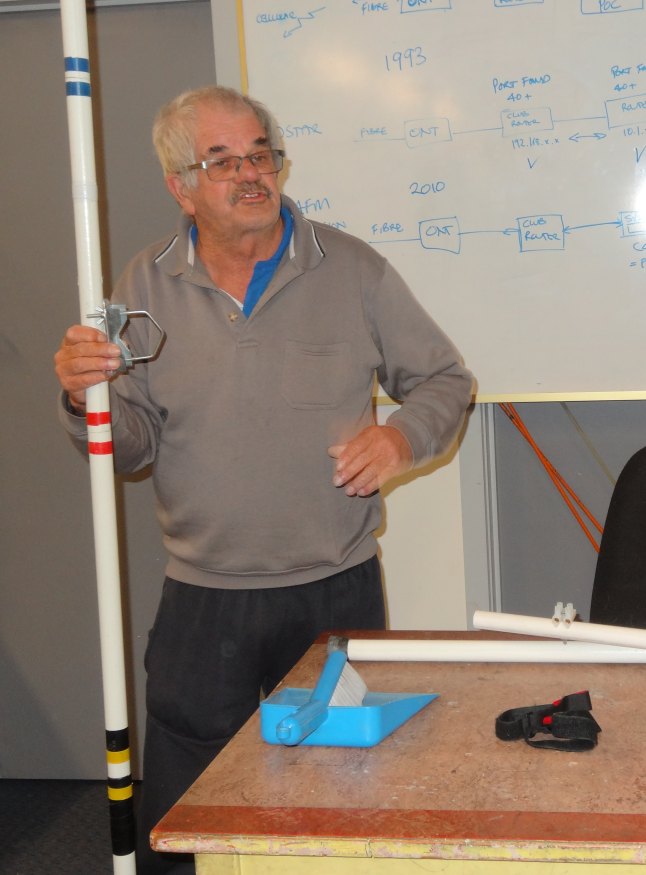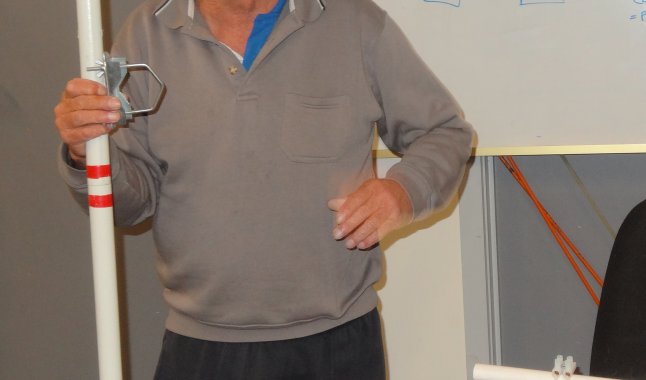The audience was only 10 of us, but we were all keen to learn from the more experienced club members. Blair ZL3TOY would seem to have more experience than some. Apparently he was licensed at just 11 years old (!).
Blair reckons when starting out, just borrow some gear to give it a try, avoid spending possibly thousands of dollars initially, as you may not even enjoy HF.
Making use of HF nets makes it easier, as no hunting for people chasing up and down through frequencies is required.
The limitations of the site often decide what antenna is going to be easiest to install. A dipole can be off-centre fed, and there are end fed options also. In areas where local rules (like in retirement villages that don’t even allow a satellite dish) there have even been wire antennas simply installed being run around the inner edge of the roof-cavity, underneath a clay tile roof.
The Flat Top, the Inverted Vee and the Vertical are usually bottom fed. The Inverted Vee he said, works “So (very) well”. A drawing on the whiteboard showed how 80% of the signal radiates from an inverted vee at a low angle (just right for HF DXing).
The first half of a vertical antenna, we were told does 80% of the work, so there is actually a way of end feeding a vertical from the top, with the coax running up the centre.
Questions came from the floor about the height of antennas allowed in residential areas of Christchurch City, inspired by a recent front page newspaper article. (I won’t name Mike S. for fear of embarrassing him). Blair assured us that 19.1 metres is within the rules (as long as the cross sectional area at the base is small).
I’ve got disappointing news for folks wanting to do serious HF work while mobile in their car. Apparently mobile HF whip antennas are only about 1% efficient. Automatic adjusting “screwdriver” antennas boost the efficiency up to between 2% and 3%.
Discussing efficiencies overall, Blair reckons that 90% of HF DXing is done by the ionosphere. So there ain’t nuthin’ you can do about controlling that (just choose the right time of day/night for the band you’re on).
Of the remaining 10% total, Your antenna does about 9% and your radio about 1%. These are the only two things we can control, so that’s why getting the antenna right, is the most important aspect. Leaving the blue sky out of it, means that your antenna is 90% and your radio is 10% when it comes to HF DXing.
Blair reckons that “50% of everything you’ve been taught, is (rubbish) !” This is simply because our understanding of the science behind electronics and radio has increased so much over the years.
The transmitters in modern radios haven’t improved as much over the years as the receive circuits have. For some people, an older transceiver rig, but with a dedicated SDR (Software Defined Receiver) to listen in on, could be a good setup for a beginner’s shack on a limited budget.
The tag-team switched out as Rick ZL3RIK took over.

“First” he said “Listen. Listen. Listen” and remember that you may not be able to hear, the other side of (an apparently one sided) conversation.
Use phonetics for your call sign. Listen out for stations saying “QRZ” (who is calling me). But if you hear “QRX” (“do not transmit”) that’s their way of telling you to blimmin’ well shut up !
Check your Call book for the latest band plans for Digi modes only, talk only and SSTV only.
Remember that “the higher the sun, the higher the frequency”. 20 metres seems best in the day with 40 metres around the “grey line” of dusk and dawn. But Blair reckoned that 80 metres runs all day long at his place !
Thanks to Blair and Rick for sharing this information for us folks who are new to HF.
Author Catherine ZL3CATH


